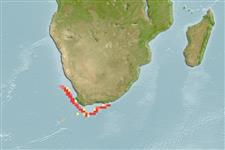Environment: milieu / climate zone / depth range / distribution range
Ecología
marino batidemersal; no migratorio; rango de profundidad 549 - 1737 m (Ref. 1371). Deep-water; 30°S - 39°S, 14°E - 26°E (Ref. 1371)
Southeast Atlantic: known only from off the Orange River mouth to south of False Bay, South Africa.
Tamaño / Peso / Age
Maturity: Lm ? range ? - ? cm
Max length : 26.0 cm TL macho / no sexado; (Ref. 1371)
Short description
Morfología | Morfometría
Espinas dorsales (total): 2; Radios blandos dorsales (total): 149-151. Eyes large; snout short, acutely pointed, with well-developed terminal scute; underside of the snout, most of the suborbital, and anterior part of the mandible mostly naked. Spinules on body scales broadly lanceolate to shield-shaped, arranged in somewhat converging rows. Overall color is brownish; abdomen violaceous; gill membranes blackish; fins dusky. Also Ref. 2800.
Life cycle and mating behavior
Madurez | Reproducción | Puesta | Huevos | Fecundidad | Larva
Cohen, D.M., T. Inada, T. Iwamoto and N. Scialabba, 1990. FAO species catalogue. Vol. 10. Gadiform fishes of the world (Order Gadiformes). An annotated and illustrated catalogue of cods, hakes, grenadiers and other gadiform fishes known to date. FAO Fish. Synop. 125(10). Rome: FAO. 442 p. (Ref. 1371)
IUCN Red List Status (Ref. 130435)
Threat to humans
Harmless
Human uses
Pesquerías: pesquerías de subsistencia
Más información
Nombres comunesSinónimosMetabolismoDespredadoresEcotoxicologíaReproducciónMadurezPuestaAgregación para la puestaFecundidadHuevosEgg development
Age/SizeCrecimientoLength-weightLength-lengthLength-frequenciesMorfometríaMorfologíaLarvaDinámica larvariaReclutamientoAbundanciaBRUVS
ReferenciasAcuiculturaPerfil de acuiculturaRazasGenéticaElectrophoresesheritabilidadEnfermedadesProcesamientoNutrientsMass conversion
Herramientas
Special reports
Download XML
Fuentes de Internet
Estimates based on models
Preferred temperature (Ref.
123201): 3.1 - 7.1, mean 3.7 °C (based on 8 cells).
Phylogenetic diversity index (Ref.
82804): PD
50 = 0.5000 [Uniqueness, from 0.5 = low to 2.0 = high].
Bayesian length-weight: a=0.00219 (0.00111 - 0.00431), b=3.20 (3.03 - 3.37), in cm total length, based on LWR estimates for this (Sub)family-body shape (Ref.
93245).
Nivel trófico (Ref.
69278): 3.3 ±0.1 se; based on size and trophs of closest relatives
Resiliencia (Ref.
120179): Bajo, población duplicada en un tiempo mínimo de 4.5-14 años (Preliminary K or Fecundity.).
Fishing Vulnerability (Ref.
59153): Low vulnerability (16 of 100).
